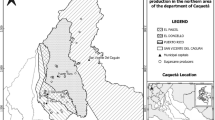Abstract
The cane growing area along the Nile valley in Upper Egypt has expanded. Most of farmer holdings are small, typically ranging from 0.5 to 1 hectare. Cane delivery schedules and consequently harvesting dates mainly depend on the delivery allocation and the date of harvest last season. The mill administration assigns a transport vehicle (main vehicle) for each farmer according to the schedule. Farmer/s harvest and transport cane from inside field/s (using a tractor-pulled-trailers) to temporary storage sites at which the main vehicle/s are loaded. Loader efficiency can be low due to time losses associated with travel from one storage site to another. To achieve reasonable efficiency of the loader, storage sites may be amalgamated allowing greater utilisation of loaders. This procedure may increase the infield transport distance which may reduce the rate of cane supply from fields, thus contributing to increased cane delivery delay. Farmers may have to transport a part of the main vehicle load to the storage site the previous day to secure continuous operation of the loader. In this study, loader efficiency, loading rate, the percentage of main vehicle/s load/s delayed more than 24 h and cane collection efficiency were studied. In most cases, one main vehicle was assigned to each farmer, where a trailer pulled by tractor was used to transfer cane from inside the field to the storage area. Results showed that total efficiency of the loader was 75% in case of loading lorries in a large storage area and 81% in case of railway wagons loaded at a station. Average total efficiency of the loader was 61% when loading decauvelle wagons distributed in several storage areas within the same production region. Efficiency of loading tractor trailers in the field was 54%. Maximum efficiency was observed to be achieved if the loader works for the full operational day in one storage area. Cane collection efficiency was variable for the variable operating conditions. The percent of cane delayed more than 24 h was also estimated. Large temporary storage areas at which lorries are loaded with cane, and cane loading stations for railway wagons may represent more optimal conditions for loader operation. The paper discusses the efficiency of loader operation under a range of variable conditions, and related cane delivery delay. The results highlight the role of loader operation efficiency as a factor determining the adoption of mechanical loading of sugarcane. Recommendations for proper operation of cane loader are suggested.
Similar content being viewed by others
References
Abdel-Mawla, HA, El-Lithy A (2006). An expert system approach for selecting sugarcane transport systems. Paper presented to the conf. of Misr Society of A. Engineering. 23(4): 894–908.
Abdel-Mawla HA (2000). Analysis of cane delay of traditional delivery systems: Paper presented to the MSAE, Menofia Univ.: 25–26 October, 2000.
Blackburn F (1984). Reaping and transport. Sugar-cane. Chapter 9: 161–288.
Cochran BJ, Whitney RW (1976). A technique for designing transports systems for sugar-cane, Agricultural Engineering. Proc. Int. Soc. Sugar Cane Technol. 15: 2069–2079.
Meyer E (2007). An overview of the South African Sugarcane Industry. Sugar Jour. July: 9–11.
Edilbert A, Uichanco EA (1977). Mechanising the sugar industry in the Philippines. Spring AMA 17–20.
Eggleston G, Legendre B, Richard C (2001). Effect of harvesting methods and storage time on sugarcane deterioration: International Sugar J. 103 (1232): 331–338.
Hancsen AC, Barnes AJ, Lyne PW L (1998). An integrated approach to simulating sugarcane harvest-to-mill delivery systems. Paper presented at the 1998 ASAE: July 12–15: 1999.
Legal P-Y, Requis E (2002). The management of cane harvest at the small scale growth level: A South African case study. Proc. S. Afr. Sug. Technol Ass. 76: 83–93.
Libunao OS (1978). Modelling a sugar-cane transportation system for simulation in the Philippines. Proc. Int. Soc. Sugar Cane Technol. 16: 2081–2092.
Saif El-yazal N, Abdel-Mowla HA (1994). Cane loading and transporting in Egypt. Int. Sugar J. 96(1150E): 424–426.
Uichanco EA (1976). Mechanisation and increased efficiency in sugarcane production: An industry goal. AMA 7(4): 41–44.
Yang SJ, Wang CH (1993). Performance evaluation of mechanical loading of sugar-cane in Fiji. Taiwan Sugar 3: 27–29.
Author information
Authors and Affiliations
Corresponding author
Rights and permissions
About this article
Cite this article
Abdel-Mawla, H.A. Efficiency of mechanical cane loading in Egypt. Sugar Tech 12, 108–114 (2010). https://doi.org/10.1007/s12355-010-0022-8
Received:
Accepted:
Published:
Issue Date:
DOI: https://doi.org/10.1007/s12355-010-0022-8




